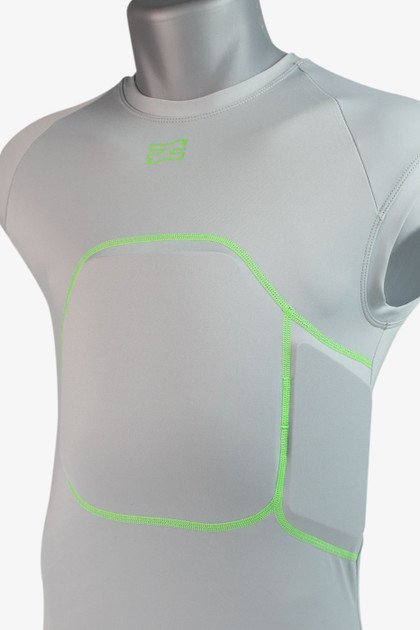
Commotio Cordis
What is Commotio Cordis
Commotio cordis (pronounced ke-MO-she-o-KORD-is) is a serious condition characterized by a sudden, life-threatening arrhythmia, commonly ventricular fibrillation, caused by an object (usually something small and hard like a baseball, lacrosse ball, or hockey puck) striking the chest directly over the heart at a very critical time during a heartbeat —known as the "vulnerable period"—which can disrupt the heartbeat and lead to sudden cardiac arrest.
A normal heart's electrical activity, which repeats with the same rhythm, looks like this recorded with an electrocardiogram.
If the chest receives a hard blow in the early stage of the T wave (the shaded area represents the critical 20- to 40-millisecond window), a commotio cordis (“agitation of the heart” in Latin) can make the heart stop.
Damar Hamlin confirmed the cause of his near-fatal collapse on "Monday Night Football" as commotio cordis, a rare event caused by a blow to the chest.Important Facts
Cause and Timing: Commotio Cordis happens when there is a direct hit to the chest, often from a baseball or hockey puck, or during sports contact. The impact must occur at a specific moment in the heart's electrical cycle, making it rare but very serious.
Symptoms: Affected individuals may suddenly collapse, lose consciousness, and have no pulse. Quick recognition and action are critical.
Prevalence: Commotio Cordis is one of the top causes of sudden cardiac arrest in young athletes.
Survival Rate: Survival chances depend on how quickly and effectively emergency help is given. Immediate CPR and defibrillation are essential.
Prevention: Wearing protective gear like chest protectors can lower risk. Education and awareness are important.
Response: Training for coaches, athletes, and bystanders in CPR and using automated external defibrillators (AEDs), along with a clear emergency action plan, can greatly improve outcomes.
This sequence, which repeats with each heartbeat, has three key components: P Wave, R Wave, and T wave.
In October 2022, Iona University baseball player Nick DiCarlo experienced commotio cordis during practice. His coach quickly administered CPR, and paramedics arrived with an AED, which successfully restored his heartbeat. 
Understanding Sudden Cardiac Arrest
Sudden Cardiac Arrest
Sudden Cardiac Arrest (SCA) is a life threatening emergency that occurs when the heart suddenly stops beating. It strikes people of all ages who may seem to be healthy, even children and teens. When SCA happens, the person collapses and doesn’t respond or breathe normally. They may gasp or shake as if having a seizure. SCA leads to death in minutes if the person does not get help right away. Survival depends on people nearby calling 911, starting CPR¹, and using an AED² (if available) as soon as possible.
¹CPR: Cardiopulmonary resuscitation is when you push hard and fast on the center of the chest to make the heart pump. Compressions may be given with or without rescue breaths.
²AED: Automated external defibrillator is a device that analyzes the heart and if it detects a problem may deliver a shock to restart the heart’s normal rhythm
While both Sudden Cardiac Arrest and Commotio Cordis involve the sudden loss of heart function, they differ in their causes, with SCA having a broader range of triggers (heart disease, arrhythmias, genetic conditions. It is not specific to any single cause or event) and Commotio Cordis being specifically caused by a direct chest impact.
Prompt recognition and response, including CPR and defibrillation, is crucial in both cases to improve survival outcomes.
Trigger Warning: This video includes real footage of sudden cardiac arrest (SCA) in athletes, which may be distressing. It aims to educate on recognizing SCA signs and enhancing emergency responses. Please watch with caution if sensitive to graphic content.

CPR - Cardiopulmonary Resuscitation
What is CPR?
CPR stands for cardiopulmonary resuscitation.
CPR is an emergency method that uses chest compressions and rescue breaths. It is performed when a person's heart stops beating to maintain the circulation of oxygenated blood to the brain and other vital organs until help arrives.
Hands-only CPR involves only chest compressions without mouth-to-mouth breaths. It is recommended for use by bystanders. This method is easy to learn and can be performed by anyone, even without formal training.
Watch the video below to see CPR in action.
Why CPR is Important
Sustains Life - CPR provides critical blood flow to the brain and vital organs during cardiac arrest, buying time until professional help arrives.
Increases Survival Rates - Immediate CPR can DOUBLE or TRIPLE a person’s chances of survival.
Prevents Brain Damage - Keeping blood circulating helps prevent brain damage caused by lack of oxygen, which can occur within minutes of cardiac arrest
Steps to Perform Hands-Only CPR
CHECK - Check responsiveness. Tap the person on the shoulder and shout, “Are you OK?” You can also use your knuckles to rub against the person’s sternum or pinch their nailbed.
CALL - If there is no response, immediately call 911 or ask someone to do so.
COMPRESS - push hard and fast at least 2 inches deep and at a rate of 100-120 compressions per minute. Let the chest rise completely between compressions. Keep performing chest compressions until emergency responders take over or the person begins to show signs of life.
FACT: without CPR 92% die before making it to the hospital

Automated External Defibrillator (AED)
When using an Aed Follow the device’s prompts throughout the process. What is an AED?
An AED (Automated External Defibrillator) is a portable medical device that checks the heart’s rhythm and can send an electric shock to restore a normal rhythm during sudden cardiac arrest (SCA).
AEDs are designed to analyze the heart’s rhythm and only deliver a shock if necessary.
AEDs are designed for first-time non-medical users and guide users with clear, step-by-step voice instructions.
How AEDs Help
Immediate Response - the sooner an AED is used, the greater the chances of survival.
For every minute defibrillation is delayed, the chance of survival decreases by 10%.
AEDs are critical for conditions like commotio cordis and other forms of sudden cardiac arrest, which are leading causes of death in young athletes.
It's crucial to have accessible AEDs at sports venues as they can make the difference between life and death.
How to Use an AED
1. Save
Turn on the AED—Open the AED and press the power button. The AED will begin giving verbal instructions.
Place Pads on the Chest—Expose the person’s chest and place the adhesive pads as directed. Follow the diagrams on the AED. For adults and children over 8 years old or > 55 lbs, one pad goes on the upper right side of the chest and the other on the lower left side.
Use pediatric pads for Children Under 8 (or under 55 lbs).
If no pediatric pads or child mode is available, use adult pads. Place one pad between the shoulder blades on the center of the chest and the other on the back. This is called the “front-and-back” method.
Select Child or Adult mode—If you're treating a child, Press the child mode button on the AED. This adjusts the shock to a safer level for children without needing different pads.
2. SHOCK
Analyze Heart Rhythm: Allow the AED to analyze the person’s heart rhythm. The device will tell you to stand clear and determine if a shock is needed.
Deliver Shock if Advised: If the AED advises a shock, ensure no one touches the person and press the “shock” button. The AED will give further instructions if needed.
3. SAVE
Continue CPR - After the shock, start CPR again if instructed by the AED, performing chest compression until help arrives or the person starts moving. The AED may continue to monitor the heart and advise additional shocks if necessary.
Children over age 8 can be treated with a standard AED. For children ages 1–8, the AHA recommends the pediatric attenuated pads that are purchased separately. 
Protect Your Heart
Heart Protective Gear
Every year, sudden cardiac arrest caused by commotio cordis takes the lives of young athletes. Sports like baseball, lacrosse, and hockey are fun but can pose a risk to the heart due to high-speed impacts. A single blow to the chest, at just the wrong moment, can lead to this life-threatening condition.
Heart protective gear, such as chest protectors, can significantly reduce the risk of commotio cordis. Just as seat belts and helmets have become essential for car safety and skiing, heart protection should be a non-negotiable part of every athlete's uniform. These specialized chest protectors are designed to absorb the force of an impact and help shield the heart from potential harm.
“A 2017 study led by Tufts Medical Center in Boston found that chest protectors, specifically ones that incorporate Kevlar, may “be effective in the prevention of commotio cordis on the playing field.””
What to Buy
Would you drive without a seat belt?
Would you ski without a helmet?
Would you let your young athlete play sports without heart protection?
Check out Unequal’s complete line of Hart products!
Unequal CC Hart III Protective Compression Shirt
FDA issued IFU claim for HART® CC pads and the risk reduction of commotio cordis Published peer-reviewed study by Tufts Medical Center verifies effectiveness of HART® pads Field players & hitters can play with confidence knowing they are protected from dangerous impacts to chest Base-layer design is form-fitting, comfortable, & easily concealed under baseball jerseyEvoShield Youth NOCSAE Commotio Cordis Protective Chest Guard Shirt
Engineered with easy-to-wear compression fabric that’s outfitted with a removable SAS-TEC™-powered guard, the EvoShield® Protective Chest Guard Shirt offers players an ergonomically designed piece of equipment without sacrificing mobility or performance. This shirt meets the NOCSAE® Chest Protector Standard for Commotio Cordis, making it great for catchers, umpires, and even players stepping up to bat.















